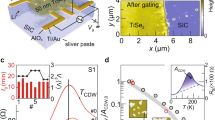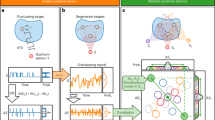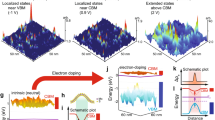Abstract
Interparticle interactions are self-conflicting rather than cooperative on particular lattices. When such geometrical frustration occurs, charge ordering (CO) can be destabilized into non-trivial charge states such as the recently observed charge glass (CG). A more extreme case is the frustration-induced quantum melting of the CO that has been theoretically proposed. Here, we report d.c. charge transport and noise spectroscopy measurements for a triangular-lattice organic conductor situated close to the CO or CG. Our experiments demonstrate that these materials can host a strange metal with unusual charge dynamics, which we attribute to frustration-induced fluctuations of the CO or CG. Our results also show that the anomalous charge fluctuations can freeze into an insulating state when uniaxial stress is applied, which reduces the geometrical frustration. The present observations suggest the existence of the frustration-induced quantum melting of charges analogous to spin liquids.
This is a preview of subscription content, access via your institution
Access options
Access Nature and 54 other Nature Portfolio journals
Get Nature+, our best-value online-access subscription
$32.99 / 30 days
cancel any time
Subscribe to this journal
Receive 12 print issues and online access
$259.00 per year
only $21.58 per issue
Buy this article
- Purchase on SpringerLink
- Instant access to full article PDF
Prices may be subject to local taxes which are calculated during checkout





Similar content being viewed by others
Data availability
The data that support the findings of this study are available from the corresponding authors on request.
References
Zhou, Y., Kanoda, K. & Ng, T.-K. Quantum spin liquid states. Rev. Mod. Phys. 89, 025003 (2017).
Anderson, P. W. Ordering and antiferromagnetism in ferrites. Phys. Rev. 102, 1008–1013 (1956).
Seo, H., Tsutsui, K., Ogata, M. & Merino, J. Charge fluctuations in geometrically frustrated charge ordering system. J. Phys. Soc. Jpn 75, 114707 (2006).
Mahmoudian, S., Rademaker, L., Ralko, A., Fratini, S. & Dobrosavljević, V. Glassy dynamics in geometrically frustrated Coulomb liquids without disorder. Phys. Rev. Lett. 115, 025701 (2015).
Yoshimi, K. & Maebashi, H. Coulomb frustrated phase separation in quasi-two-dimensional organic conductors on the verge of charge ordering. J. Phys. Soc. Jpn 81, 063003 (2012).
Kagawa, F. et al. Charge-cluster glass in an organic conductor. Nat. Phys. 9, 419–422 (2013).
Sato, T. et al. Emergence of nonequilibrium charge dynamics in a charge-cluster glass. Phys. Rev. B 89, 121102 (2014).
Sato, T. et al. Systematic variations in the charge-glass-forming ability of geometrically frustrated θ-(BEDT-TTF)2X organic conductors. J. Phys. Soc. Jpn 83, 083602 (2014).
Sato, T., Miyagawa, K. & Kanoda, K. Fluctuation spectroscopy analysis based on the Dutta–Dimon–Horn model for the charge-glass system θ-(BEDT-TTF)2CsZn(SCN)4. J. Phys. Soc. Jpn 85, 123702 (2016).
Sato, T., Miyagawa, K. & Kanoda, K. Electronic crystal growth. Science 357, 1378–1381 (2017).
Sasaki, S. et al. Crystallization and vitrification of electrons in a glass-forming charge liquid. Science 357, 1381–1385 (2017).
Hotta, C. & Furukawa, N. Strong coupling theory of the spinless charges on triangular lattices: possible formation of a gapless charge-ordered liquid. Phys. Rev. B 74, 193107 (2006).
Cano-Cortés, L., Ralko, A., Février, C., Merino, J. & Fratini, S. Geometrical frustration effects on charge-driven quantum phase transitions. Phys. Rev. B 84, 155115 (2011).
Kaneko, M. & Ogata, M. Mean-field study of charge order with long periodicity in θ-(BEDT-TTF)2X. J. Phys. Soc. Jpn 75, 14710 (2006).
Merino, J., Seo, H. & Ogata, M. Quantum melting of charge order due to frustration in two-dimensional quarter-filled systems. Phys. Rev. B 71, 125111 (2005).
Mori, H., Tanaka, S. & Mori, T. Systematic study of the electronic state in θ-type BEDT-TTF organic conductors by changing the electronic correlation. Phys. Rev. B 57, 12023–12029 (1998).
Mori, T. Non-stripe charge order in the θ-phase organic conductors. J. Phys. Soc. Jpn 72, 1469–1475 (2003).
Kondo, R. et al. Electrical and structural properties of θ-type BEDT-TTF organic conductors under uniaxial strain. J. Phys. Soc. Jpn 75, 044716 (2006).
Kobayashi, H. et al. A new molecular superconductor, (BEDT-TTF)2(I3)1-x(AuI2)x (x < 0.02). Chem. Lett. 15, 789–792 (1986).
Kobayashi, A. et al. Anion arrangement in a new molecular superconductor, θ-(BEDT-TTF)2(I3)1-x(AuI2)x,(x < 0.02). Chem. Lett. 15, 2017–2020 (1986).
Tamura, M. et al. Analysis of de Haas–van alphen oscillations and band structure of an organic superconductor, θ-(BEDT-TTF)2I3. J. Phys. Soc. Jpn 63, 615–622 (1994).
Takenaka, K. et al. Collapse of coherent quasiparticle states in θ-(BEDT-TTF)2I3 observed by optical spectroscopy. Phys. Rev. Lett. 95, 227801 (2005).
Hussey, N. E., Takenaka, K. & Takagi, H. Universality of the Mott–Ioffe–Regel limit in metals. Philos. Mag. 84, 2847–2864 (2004).
Dutta, P., Dimon, P. & Horn, P. M. Energy scales for noise processes in metals. Phys. Rev. Lett. 43, 646–649 (1979).
Dutta, P. & Horn, P. M. Low-frequency fluctuations in solids: 1/f noise. Rev. Mod. Phys. 53, 497–516 (1981).
Weissman, M. B. What is a spin glass? A glimpse via mesoscopic noise. Rev. Mod. Phys. 65, 829–839 (1993).
Müller, J., Brandenburg, J. & Schlueter, J. A. 1/f noise in the quasi-two-dimensional organic conductor κ-(BEDT-TTF)2Cu[N(CN)2]Cl. Phys. Rev. B 79, 214521 (2009).
Hirata, M., Miyagawa, K., Kanoda, K. & Tamura, M. Electron correlations in the quasi-two-dimensional organic conductor θ-(BEDT-TTF)2I3 investigated by 13C NMR. Phys. Rev. B 85, 195146 (2012).
Scofield, J. H., Mantese, J. V. & Webb, W. W. Temperature dependence of noise processes in metals. Phys. Rev. B 34, 723–731 (1986).
Weissman, M. B. 1/f noise and other slow, nonexponential kinetics in condensed matter. Rev. Mod. Phys. 60, 537–571 (1988).
Raquet, B., Coey, J. M. D., Wirth, S. & von Molnár, S. 1/f noise in the half-metallic oxides CrO2, Fe3O4, and La2/3Sr1/3MnO3. Phys. Rev. B 59, 12435–12443 (1999).
Müller, J. Fluctuation spectroscopy: a new approach for studying low-dimensional molecular metals. ChemPhysChem 12, 1222–1245 (2011).
Bloembergen, N., Purcell, E. M. & Pound, R. V. Relaxation effects in nuclear magnetic resonance absorption. Phys. Rev. 73, 679–712 (1948).
Joubaud, S., Petrosyan, A., Ciliberto, S. & Garnier, N. B. Experimental evidence of non-Gaussian fluctuations near a critical point. Phys. Rev. Lett. 100, 180601 (2008).
Hartmann, B., Zielke, D., Polzin, J., Sasaki, T. & Müller, J. Critical slowing down of the charge carrier dynamics at the Mott metal-insulator transition. Phys. Rev. Lett. 114, 216403 (2015).
Cano-Cortés, L., Merino, J. & Fratini, S. Quantum critical behavior of electrons at the edge of charge order. Phys. Rev. Lett. 105, 036405 (2010).
Tamura, M., Matsuzaki, F., Tajima, N., Nishio, Y. & Kajita, K. Transport study of an organic conductor, θ-(BEDT-TTF)2I3. Synth. Met. 86, 2007–2008 (1997).
Tajima, N. et al. Pressure control of transport property of organic conductors; α-, θ-(BEDT-TTF)2I3 and θ-(DIETS)2[Au(CN)4]. J. Phys. IV 114, 263–267 (2004).
Kajita, K. et al. New organic superconductors κ- and θ-(BEDT-TTF)2I3: transport property. Solid State Commun. 64, 1279–1284 (1987).
Mori, H., Tanaka, S., Mori, T., Kobayashi, A. & Kobayashi, H. Crystal structure and physical properties of M = Rb and Tl salts of (BEDT-TTF)2MM’(SCN)4 (M’ = Co, Zn). Bull. Chem. Soc. Jpn 71, 797–806 (1998).
Maesato, M., Kaga, Y., Kondo, R. & Kagoshima, S. Uniaxial strain method for soft crystals: application to the control of the electronic properties of organic conductors. Rev. Sci. Instrum. 71, 176–181 (2000).
Acknowledgements
This work was supported in part by the Japan Society for the Promotion of Science (JSPS) KAKENHI under grant no. 25220709 and Grants-in-Aid for Scientific Research (nos 15H00988, 16K05744, 17K05532, 24340074, 16H04010 and 18H05225) from the JSPS, Japan, and the Canon Foundation. T.S. was supported as a JSPS Research Fellow (no. 14J07870).
Author information
Authors and Affiliations
Contributions
T.S. performed the d.c. transport measurements. T.S. and K. Kitai performed the noise measurements. T.S. and K.M performed 1H NMR measurements. K.M., M.T., A.U. and H.M. grew the single crystals used for the study. K. Kanoda planned the project. T.S. and K. Kanoda wrote the manuscript. All authors discussed the results and commented on the manuscript.
Corresponding authors
Ethics declarations
Competing interests
The authors declare no competing interests.
Additional information
Publisher’s note: Springer Nature remains neutral with regard to jurisdictional claims in published maps and institutional affiliations.
Supplementary information
Supplementary Information
Supplementary Figures 1–10, Supplementary References 1–7
Rights and permissions
About this article
Cite this article
Sato, T., Kitai, K., Miyagawa, K. et al. Strange metal from a frustration-driven charge order instability. Nature Mater 18, 229–233 (2019). https://doi.org/10.1038/s41563-019-0284-9
Received:
Accepted:
Published:
Issue date:
DOI: https://doi.org/10.1038/s41563-019-0284-9
This article is cited by
-
Nucleation and growth of orbital ordering
Nature Communications (2020)



